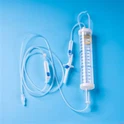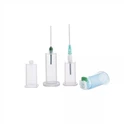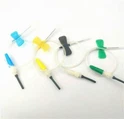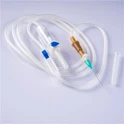1. Contrast
After successful puncture, the control group used traditional methods to fix the needle handle and the puncture point according to the operating procedures in basic nursing, that is, fixed with 4 tapes. First, the first tape was fixed across the needle handle; the second was with small yarn blocks. The infusion patch is fixed at the skin puncture point; the third piece of adhesive tape crosses the plastic tube at the tail of the needle handle and is folded upwards and cross-fixed; the fourth piece of adhesive tape fixes the scalp needle plastic tube on the scalp in front of the scalp needle. When removing the needle, loosen all the tape and press the puncture point with a cotton swab.
2. Observe
The observation group also used 4 strips of adhesive tape. In the first step, the needle handle was fixed horizontally, and then 1 infusion patch with small gauze block was used to fix the puncture point. The fixed position was indicated by the puncture point, and the tape that did not stick to the needle handle was used as Correct, the third step is to reflex the infusion needle tube into a loop and fix it in a clockwise direction to avoid the direction of the blood vessel and when the needle is fixed, the adhesive tape should also avoid the infusion patch at the puncture point, and do not overlap or overlap with the infusion patch here. Adhesion. Step 4 Use tape to fix it on the upper 2cm of the filter screen of the infusion tube. When fixing, pinch the tape through the infusion tube with your hand to make the tape stick to the infusion tube, pinch it firmly, and then stick it to the skin. In short, the second and third tapes can be parallel or partially overlapped, but they are not suitable for sticking to the infusion patch at the skin puncture point. When the needle is withdrawn, the infusion tape that fixes the puncture point will not move. Loosen the tape in the reverse order of the fixation, that is, first loosen the tape on the filter screen, then loosen the tape on the loop, and then loosen the tape on the needle handle. At this time, the left thumb can gently press the needle handle to prevent the scalp needle from rotating. When loosening the tape, you can use your middle finger to fix the skin at the edge of the tape to prevent the tape from pulling the skin excessively. When removing the needle, use your right hand to reflex the infusion needle at a position 2-3 cm away from the needle handle, and the left index finger to tighten the patient’s skin 2 cm above the needle tip, and place the thumb of the thumb on the infusion patch at the puncture point longitudinally along the blood vessel, and wait for the disposable scalp When the needle is pulled out of the blood vessel, press the infusion patch quickly without too much force, just 3-4 minutes.
3. Evaluation criteria
Evaluate the fixation effect of different disposable scalp needle fixation methods in the two groups of patients during the infusion process and the pain degree of the puncture point during the needle removal process. If there is a loosening of the tape, needle tingling, needle slippage, and puncture of the vein during the infusion, it is necessary Adjusting or refixing is fixed for repair. Effective: the infusion process is smooth, without repair and fixation, the puncture point is painful or only slightly pain during the needle removal process; ineffective: the infusion is faulty or interrupted, it needs to be repaired and fixed, and the puncture point pain is obvious during the needle removal process. The results of the two groups were tested by γ test, and P<0.05 was considered statistically significant.






